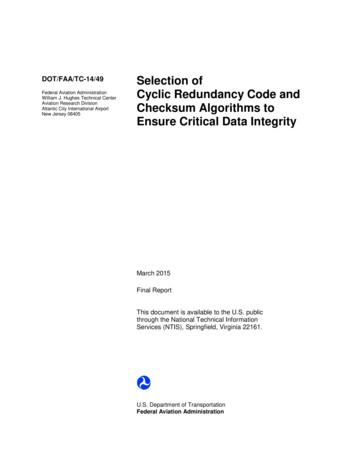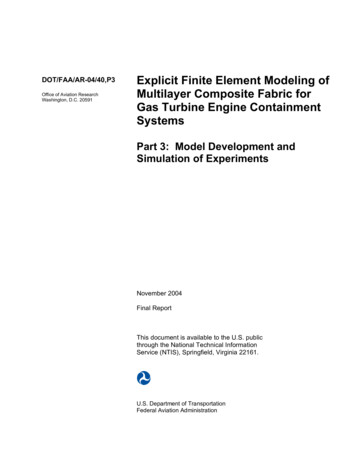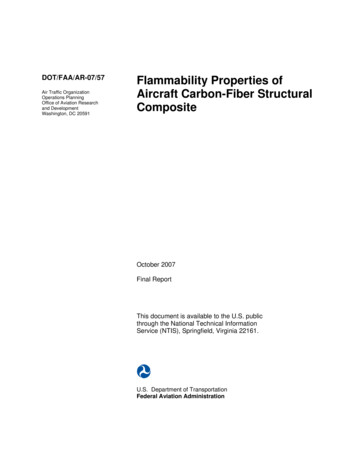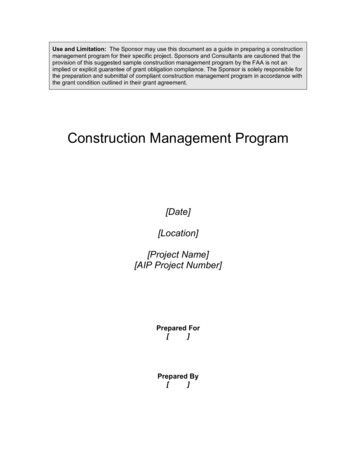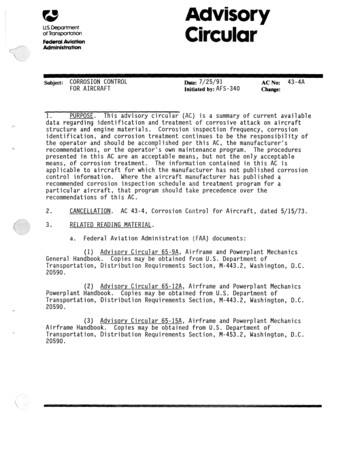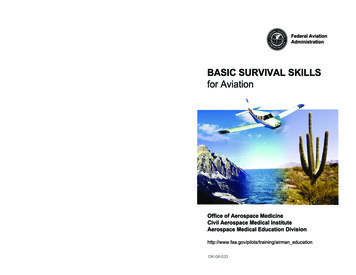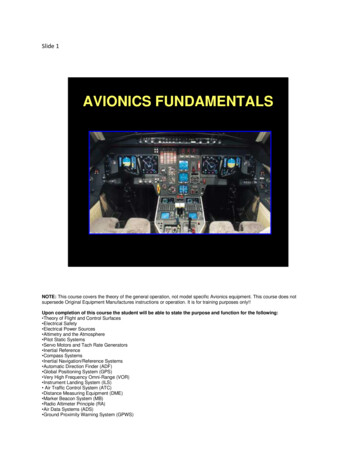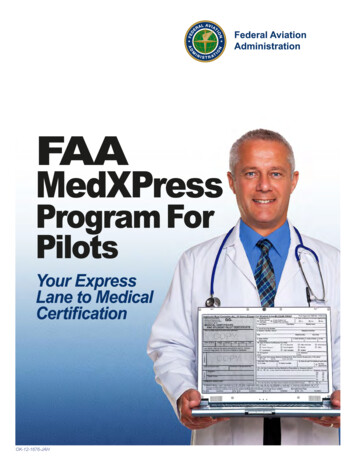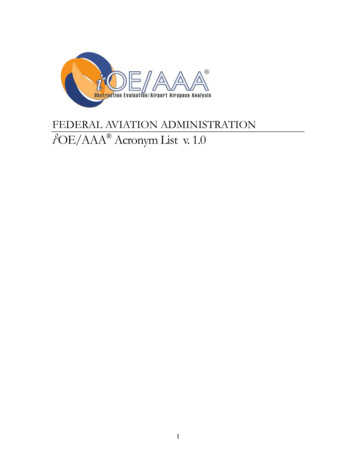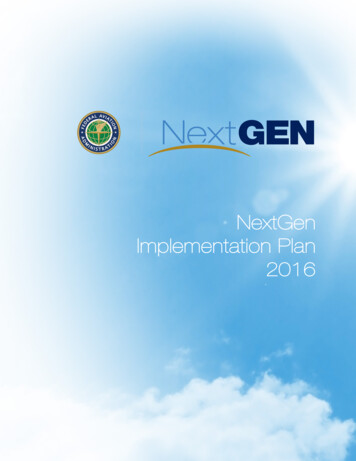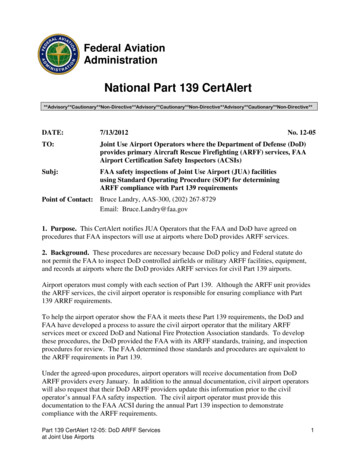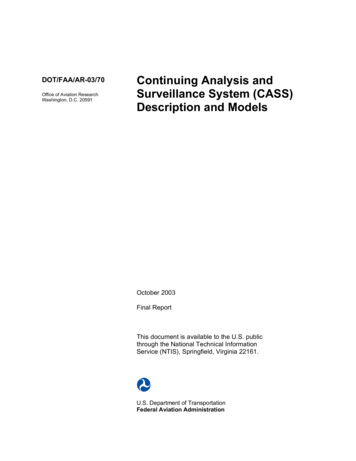
Transcription
DOT/FAA/AR-03/70Office of Aviation ResearchWashington, D.C. 20591Continuing Analysis andSurveillance System (CASS)Description and ModelsOctober 2003Final ReportThis document is available to the U.S. publicthrough the National Technical InformationService (NTIS), Springfield, Virginia 22161.U.S. Department of TransportationFederal Aviation Administration
NOTICEThis document is disseminated under the sponsorship of the U.S.Department of Transportation in the interest of information exchange. TheUnited States Government assumes no liability for the contents or usethereof. The United States Government does not endorse products ormanufacturers. Trade or manufacturer's names appear herein solelybecause they are considered essential to the objective of this report. Thisdocument does not constitute FAA certification policy. Consult your localFAA aircraft certification office as to its use.This report is available at the Federal Aviation Administration William J.Hughes Technical Center's Full-Text Technical Reports page:actlibrary.tc.faa.gov in Adobe Acrobat portable document format (PDF).
Technical Report Documentation Page1. Report No.2. Government Accession No.3. Recipient's Catalog No.DOT/FAA/AR-03/704. Title and Subtitle5. Report DateCONTINUING ANALYSIS AND SURVEILLANCE SYSTEM (CASS)DESCRIPTION AND MODELSOctober 20037. Author(s)8. Performing Organization Report No.6. Performing Organization CodeFred J. Leonelli9. Performing Organization Name and Address10. Work Unit No. (TRAIS)FJ Leonelli Group Inc.Aviation Systems ConsultantsAshburn, VA 2014711. Contract or Grant No.DTFA01-98-C0006912. Sponsoring Agency Name and Address13. Type of Report and Period CoveredU.S. Department of TransportationFederal Aviation AdministrationOffice of Aviation ResearchWashington, DC 20591Final Report14. Sponsoring Agency CodeAFS-30015. Supplementary NotesThe FAA William J. Hughes Technical Center Technical Monitor was Mr. Michael Vu, Risk Analysis Branch, AAR-490.16. AbstractSince 1964, all air carriers have been required by regulation to conduct continuous evaluations of their maintenance programs.Specifically, Title 14 Code of Federal Regulations (CFR) Parts 121.373 and 135.431 require air carriers to establish a ContinuingAnalysis and Surveillance System (CASS) to evaluate, analyze, and correct deficiencies in the performance and effectiveness oftheir inspection and maintenance programs. While the regulation governing CASS is short, its sparse language nonethelessrequires a complex system. Each CASS must set high goals, and the Federal Aviation Administration (FAA) is empowered bythe regulations to require changes to an air carrier’s maintenance program if it shows signs of weakness.To assist industry maintenance personnel and FAA inspectors to understand and comply with CASS requirement, this reportproposes three models that illustrate how the structure of CASS can be established based on an air carrier’s size and complexity.Each model represents a complete system that should meet, or exceed, the regulatory requirements, and on which new entrant aircarriers can base their CASS. Existing air carriers can also use the models as a comparison to their existing CASS and determineits effectiveness.The results in this report are based on the information gathered through research and on-site interviews with industry, FAA, andtrade association representatives. Interviews of eighteen 14 CFR Part 121 air carriers, five 14 CFR Part 135 air carriers, fouraviation industry associations, and a representative of the Joint Aviation Authorities of Europe were conducted over a 6-monthperiod. Interviews of personnel at the FAA Flight Standards District Office, Certificate Management Office, and Headquarterswere also conducted to gain input from the regulatory perspective.17. Key Words18. Distribution StatementModel, Aircraft maintenance, Safety, FAA, Air carrierThis document is available to the public through the NationalTechnical Information Service (NTIS) Springfield, Virginia22161.19. Security Classif. (of this report)UnclassifiedForm DOT F1700.720. Security Classif. (of this page)Unclassified(8-72)Reproduction of completed page authorized21. No. of Pages4122. Price
TABLE OF CONTENTSPageEXECUTIVE SUMMARY1.FUNDAMENTALS OF CONTINUING ANALYSIS AND SURVEILLANCESYSTEM11.11.21.3IntroductionContinuing Analysis and Surveillance System CharacteristicsData Collection1111.3.1 Routine Data1.3.2 Surveillance Data1.3.3 Other Data223Continuing Analysis and Surveillance System as a Closed-Loop SystemContinuing Analysis and Surveillance System 1.52.SurveillanceControlsAnalysisCorrective ActionFollow-UpBenefits of CASSCONTINUING ANALYSIS AND SURVEILLANCE SYSTEM alysisSurveillance Data Analysis78892.4.1 Root Cause Analysis2.4.2 Risk Analysis2.4.3 Analysis Process2.4.4 Human Factors9101112Performance Data AnalysisCorrective ActionFollow-Up1314152.52.62.73.viiCHARACTERISTICS OF AN EFFECTIVE CASS183.118Measuring CASS Effectivenessiii
3.23.33.43.53.63.73.84.Minimum CASS ElementsScope of AuditsAuditor QualificationsAnalyst QualificationsRole of Outside AuditorsAdequate ResourcesVoluntary Disclosures19202021212222CONTINUING ANALYSIS AND SURVEILLANCE SYSTEM MODELS224.1CASS Model 1: Large 14 CFR Part 121 Air ve ActionFollow-UpExampleSummaryCASS Model 2: Medium 14 CFR Part 121 or Large Part 135 Air 26272727SurveillanceControlsAnalysisCorrective ActionFollow-UpExampleSummaryCASS Model 3: 14 CFR Part 135 Air 29292930SurveillanceControlsAnalysisCorrective ActionFollow-UpExampleSummary5.RELATED DOCUMENTATION316.CONCLUDING REMARKS32iv
LIST OF FIGURESFigurePage1Risk Response Matrix112Continuing Analysis and Surveillance System Surveillance Process Flowchart173Continuing Analysis and Surveillance System Analysis Process Flowchart184Continuing Analysis and Surveillance System Process Functional Diagram forCASS Model 125Continuing Analysis and Surveillance System Process Functional Diagram forCASS Model 228Continuing Analysis and Surveillance System Process Functional Diagram forCASS Model 33156LIST OF TABLESTable1PageContinuing Analysis and Surveillance System Elementsv19
GLOSSARY OF ELMISMRROEMQAQCRIIRVSMSAISBSUPVDRPVPCode of Federal RegulationsAdvisory CircularAircraft Communications Addressing and Reporting SystemsAviation Safety Reporting SystemContinuous Airworthiness Maintenance ProgramCoordinating Agencies for Supplier’s EvaluationContinuing Analysis and Surveillance SystemConfiguration Deviation ListCASS Review BoardExtended-Range Twin-Engine OperationsFederal Aviation AdministrationMinimum Equipment ListMechanical Interruption SummaryMechanical Reliability ReportOriginal Equipment ManufacturerQuality AssuranceQuality ControlRequired Inspection ItemReduced Vertical Separation MinimumsSafety Attribute InspectionService BulletinSuspected Unapproved PartVoluntary Disclosure Reporting ProgramVice Presidentvi
EXECUTIVE SUMMARYSince 1964, all air carriers have been required by regulation to conduct continuous evaluations oftheir maintenance programs. Specifically, Title 14 Code of Federal Regulations (CFR) Parts121.373 and 135.431 require air carriers to establish a Continuing Analysis and SurveillanceSystem (CASS) to evaluate, analyze, and correct deficiencies in the performance andeffectiveness of their inspection and maintenance programs. These regulations do notdistinguish between maintenance functions the air carrier accomplishes and those that it contractsout. Nevertheless, the responsibility for CASS remains with the air carrier.CASS is an air carrier quality assurance system, and must consist of the following functions:surveillance, controls, analysis, corrective action, and follow-up. Together, these functions forma closed-loop system that allows the air carrier to monitor the quality of its maintenance. In astructured and methodical manner, CASS provides air carriers with the necessary information tomake decisions and reach their maintenance program objectives. Furthermore, if CASS is usedproperly, it becomes an inherent part of the air carrier’s way of doing business and helps promotea safety culture within the company.While the regulation governing CASS is short, its sparse language nonetheless requires acomplex system. Each CASS must set high goals, and the Federal Aviation Administration(FAA) is empowered by the regulations to require changes to an air carrier’s maintenanceprogram if it shows signs of weakness.To assist industry maintenance personnel and FAA inspectors to understand and comply withCASS requirement, this research proposes three models that illustrate how the structure of CASScan be established based on an air carrier’s size and complexity. Each model represents acomplete system that should meet, or exceed, the regulatory requirements, and on which newentrant air carriers can base their CASS. Existing air carriers can also use the models as acomparison to their existing CASS and determine its effectiveness.The results in this report are based on the information gathered through research and on-siteinterviews with industry, FAA, and trade association representatives. Interviews of eighteen 14CFR Part 121 air carriers, five 14 CFR Part 135 air carriers, four aviation industry associations,and a representative of the Joint Aviation Authorities of Europe were conducted over a 6-monthperiod. Interviews of personnel at the FAA Flight Standards District Office, CertificateManagement Office, and Headquarters were also conducted to gain input from the regulatoryperspective.vii/viii
1. FUNDAMENTALS OF CONTINUING ANALYSIS AND SURVEILLANCE SYSTEM.1.1 INTRODUCTION.In response to a joint study conducted by the Federal Aviation Administration (FAA) and theNational Transportation Safety Board related to a series of maintenance-related accidents andincidents, the FAA introduced regulatory requirements in 1964 mandating that air carriersestablish and maintain a Continuing Analysis and Surveillance System (CASS). This wouldprovide a structured process for monitoring the performance and effectiveness of theirinspection, maintenance, preventive maintenance, and alterations programs. The CASS ensuresa means to correct any deficiency in those programs, regardless of whether the programs arecarried out by the air carrier itself or by any other entity (Title 14 Code of Federal AviationRegulations (CFR), Parts 121.373 and 135.431.)While the regulation governing CASS is short, this sparse language nonetheless requires acomplex system. Each CASS must set high goals. The FAA is empowered by the regulations torequire changes to an air carrier’s maintenance program if it shows signs of weakness.The regulation can be summarized as a requirement for air carriers to establish and use a systemfor the continuing analysis and surveillance of the performance and effectiveness of theirprograms. These emphasized words, which are taken directly from the regulation, form the coreof what a CASS must address.1.2 CONTINUING ANALYSIS AND SURVEILLANCE SYSTEM CHARACTERISTICS.CASS is an air carrier quality assurance system. In a structured and methodical manner, CASSprovides air carriers with the necessary information needed to make decisions and reach theirmaintenance program objectives. Furthermore, if CASS is used properly, it becomes an inherentpart of the air carrier’s way of doing business and helps promote a safety culture within thecompany.CASS monitors various programs, primarily the air carrier’s Continuous AirworthinessMaintenance Programs (CAMP), which includes inspection. All air carriers have a CAMP toensure that their aircraft are properly maintained. The primary function of CASS is to ensurethat each air carrier’s CAMP is effective. A working CAMP prevents premature failures whileincreasing aircraft and parts reliability and overall safety. In an ideal world, the air carrier’sCAMP would ensure that there were no events between scheduled aircraft checks. In reality,each CAMP must be continually adjusted to move towards this ideal. An effective CASS shouldidentify elements that are detrimental to the overall effectiveness of the air carrier’s CAMP andcorrect those deficiencies before they become systemic problems.1.3 DATA COLLECTION.To achieve these goals, the CASS collects data and analyzes that data from several elements ofan air carrier’s CAMP. These data can be classified into routine, audit, and other data,depending on their source.1
1.3.1 Routine Data.Routine data is that which may or may not be required by the regulations but is collected on aregular basis by air carriers, through sources such as: Aircraft inspections Scheduled maintenance Required Inspection Item (RII) program Aircraft, engine, propeller, and appliance overhaul Major repairs and alterations Reliability program (if applicable) Structural inspection program (if applicable) Mechanical reliability reports (if applicable) Special Federal Aviation Regulation 36 authority (if applicable) Special operations (i.e., Category II, Category III, Minimal Navigation PerformanceSpecification, Reduced Vertical Separation Minimums (RVSM), extended-range twinengine operations (ETOPS)) Aging aircraft issues, such as Corrosion Prevention and Control Programs, SupplementalStructural Inspection Documents, Structural Inspection Document, and structural repairassessments Nondestructive testing1.3.2 Surveillance Data.Surveillance/audit data is collected during CASS audits, from sources such as: Airworthiness responsibilities Maintenance manuals Maintenance organization and staffing Maintenance training Airworthiness Directive (AD) compliance2
Service Bulletin compliance Vendor facilities, capabilities, and performance including parts information such asexcessive usage Equipment, facilities, test/measurement equipment calibration Fueling Weight and balance Baggage and cargo Records and reporting system Parts/material control, including Suspected Unapproved Parts (SUPs) Coordinating Agencies for Supplier’s Evaluation (C.A.S.E.) Maintenance personnel duty time1.3.3 Other Data.Other data can be generated as a result of incidents or accidents, special investigations, specialaudits, or teardown analysis and are the result of an abnormality in the air carrier’s operation.This data can come from the following sources: Unscheduled maintenance, including repetitive nonroutine maintenance Deferred maintenance (Minimum Equipment Lists (MELs), Aircraft CommunicationsAddressing and Reporting Systems (ACARS), and Configuration Deviation List (CDLs)) Teardown reports Mechanical interruption summary reports Parts/material control, including SUPs1.4 CONTINUING ANALYSIS AND SURVEILLANCE SYSTEM AS A CLOSED-LOOPSYSTEM.Each CASS monitors the effectiveness and performance of its key elements. These key elements(audits, data collection, analysis, reporting, corrective action, and verification) are processes orprograms that air carriers use to achieve particular goals. Some of these elements are required by14 CFR, while others have been developed by industry or in partnership with the FAA toenhance the efficiency and/or safety of air carrier operations3
Therefore, CASS is a closed-loop system review of interrelated elements, programs, andprocesses, including people, procedures, materials, tools, equipment, operational norms, facilitiesand, as applicable, information technology. This system provides for self-evaluation feedbackwithin itself so that each air carrier’s CAMP can keep up with changes at the air carrier.Examples that justify a need for changes include fleet or route system growth, aging of fleets,route changes, and systemic concerns identified through CASS (such as a deterioration ofelements), and increased reliance on contracted maintenance. It is important to note that theregulations governing CASS do not distinguish between those maintenance functions the aircarrier performs and those that it contracts out. However, the responsibility for CASS remainswith the air carrier.The complexity and sophistication of the CASS at each air carrier should be appropriate to itssize and type of operation, and should also provide a means to accommodate the followingobjectives: Realize the levels of safety and mechanical reliability the air carrier has set. Restore the levels of safety and reliability that the air carrier has set in the eventdeterioration occurs. Collect the information necessary to identify systemic or other maintenance errorcontributors that degrade airworthiness and the level of safety and reliability that the aircarrier has set. Collect the information the air carrier needs to continuously validate that all elements ofthe air carrier’s maintenance program are being executed in accordance with the aircarrier’s manual. Collect the information the air carrier needs to continuously validate the effectiveness ofeach element of the air carrier’s maintenance program. In other words, that the goals andobjectives specified by the regulations are being met. Collect the information the air carrier needs to continuously validate the appropriatecompletion of each scheduled maintenance task and the adequacy of its associatedinterval. Compile the information the air carrier needs to improve the design of items whose levelof safety and reliability proves inadequate.1.5 CONTINUING ANALYSIS AND SURVEILLANCE SYSTEM FUNCTIONS.At a minimum, each CASS should contain the following functions.4
1.5.1 Surveillance.This function includes audits of suppliers, subcontractors, and internal airline elements toidentify factors that could lead to an accident or incident or a breakdown in maintenanceprocesses. The collected surveillance data is used in the analysis process.The surveillance function of the CASS interfaces with all audited departments should preferablybe established as a partnership for safety rather than a policing program that seeks to assignblame and punish those who make mistakes. It is generally accepted that complex systems willalways include errors and deficiencies. The purpose of any CASS is to manage risk byidentifying those shortfalls proactively (before they occur) and taking corrective action. Theevaluation of the corrective action determines the effectiveness of the intervention. As in anyother system safety approach, this process requires effective cooperation, coordination, andcommunication between relevant parties.The system safety discipline is the application of special technical and managerial skills to thesystematic forward-looking identification and control of hazards throughout the life cycle of aproject, program, or activity. Rather than taking accidents or incidents and working back to findtheir causes, the system safety approach is proactive in reducing hazards by identifying,analyzing, assessing, prioritizing, documenting risks, and take proper action.1.5.2 Controls.Controls are checks and restraints designed into a process to ensure a desired result. Controlsshould be written into the air carrier’s manual system to ensure that the manual procedures willbe followed.Controls may be in the form of administrative controls, which are secondary or supplementalwritten procedures that are put in place to ensure compliance with more important primaryprocedures. Like written procedures, administrative controls also need to provide answers toquestions, such as who, what, when, where, and how, associated with the process. Controls mayalso be in the form of engineered controls, such as automated features or mechanical actions thatare put into place to ensure compliance with the more important primary procedures. Controlsshould be implemented where a r
Maintenance Programs (CAMP), which includes inspection. All air carriers have a CAMP to ensure that their aircraft are properly maintained. The primary function of CASS is to ensure that each air carrier’s CAMP is effective. A working CAMP prevents premature failures while incr
